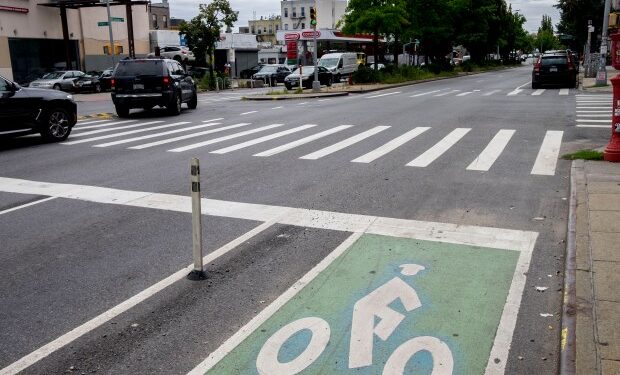New York City’s Transportation Department will begin extending Brooklyn’s McGuinness Blvd. bike lane to the south next month, the Daily News has learned — part of an effort to bring bicycle accessibility and traffic calming to the entire deadly road by year’s end.
“This redesign for McGuinness Boulevard will make this corridor much safer for everyone, including drivers, pedestrians, and cyclists,” a DOT spokesman said in a statement.
Currently, the major Greenpoint thoroughfare has curbside bike lanes running from Calyer St. to the Pulaski Bridge at the road’s northern end. The lanes are protected by jersey barriers near street corners.
During the day, that portion of the road has no provisions for parking, and two lanes of motor-vehicle travel in each direction. At 7 p.m., the outermost vehicular lane in each direction becomes a parking lane, turning McGuinness into a two-lane road. The parking lane becomes a travel lane again at 7 a.m.
Starting in September, DOT officials said, the city will begin work to reconfigure the southern section of McGuinness Blvd. — from Calyer St. to Meeker Ave. — in the same way.

“Based on community feedback, NYC DOT will be extending the protected bike lane from Calyer St. to Meeker Ave. while also delivering a new network of bike lanes, better connecting cyclists to Meeker Avenue and points south, and adding sidewalk extensions at streets intersecting McGuinness Blvd.,” a department spokesperson said in a statement.
The redesign will also involve the addition of loading zones along the boulevard, and a redesign of the on-ramp to the Brooklyn-Queens Expressway to include pedestrian access from Meeker Ave. to Bayard St.
The DOT also plans to add unprotected bike lanes to surrounding streets to better tie the McGuiness lanes into the wider bike lane network. Those lanes will include portions of Engert Ave., Bayard St., Monitor St., and Newton St.
DOT officials told The News Tuesday that they plan to complete the work by the end of the year.
McGuinness Blvd. — a major route for traffic between Greenpoint and Long Island City — had initially slated for a more comprehensive redesign following the 2021 hit-and-run killing of beloved Brooklyn teacher Matthew Jensen.
That plan, which would have permanently removed two motor vehicle lanes from the four-lane road and replaced them with protected bike lanes while maintaining street parking, got axed by Mayor Adams’ administration in 2023.
City Council member Lincoln Restler (D-Brooklyn), whose district includes the full length of McGuinness Blvd., has previously said that bike lanes are not enough to calm the concerns of his constituents, and called on the city to take steps to reduce motor vehicle traffic along the road.
Restler joined nine other elected Democratic officials — Rep. Nydia Velázquez, Public Advocate Jumaane Williams, City Comptroller Brad Lander, Brooklyn Borough President Antonio Reynoso, State Sens. Kristen Gonzalez and Julia Salazar, State Assembly member Emily Gallagher and City Council member Jennifer Gutiérrez — to voice their opposition to the DOT’s plan Tuesday afternoon in a joint statement.
“Greenpoint residents have demanded that Mayor Adams finally address the deadly conditions on McGuinness Boulevard and make our community safer, but he ignored us,” the joint statement reads.
“After repeatedly changing his mind and undermining DOT’s evidence-based redesign, Mayor Adams is going forward with a plan that fails Greenpoint by preserving the most dangerous elements of this roadway that runs through the middle of our community,” the statement continues. “We will not stop fighting until we successfully prioritize the safety of our neighbors above all else.”






